| Home |
| Acknowledgments |
| Conventions |
| Glossary |
| Maps |
| References |
| Links |
| Articles |
| Thumbnails |
| Species
list |
| Family |
| Next
species |
Additional Photos

underside

cerata detail

side, tuberculate

pink cerata bases

broken rings

more white

in field

young

with egg mass
_______________
GALLERY

Limenandra confusa Carmona, Pola, Gosliner & Cervera, 2014

| Maximum size: 14 mm. Identification: This is a slender species with papillae on the posterior edges of its rhinophores. The brown-flecked cerata are papillate and are arranged in groups that usually alternate in length. The notum is decorated with bright yellow patches and pink rings. Rarely, the cerata may have bright pink bases. In some animals, the notum may be tuberculate and the yellow pigment may be confined to the tubercles. Rarely, the pink pigment may be reduced to a central dot or be completely obscured by white pigment. Natural history: Limenandra confusa is a moderately common diurnal species found in protected to exposed rocky habitats and in Halimeda kanaloana beds. It occurs at < 1 to 18 m (< 3 to 59 ft). It jerks its cerata rhythmically while crawling and lays a weakly "kinked", white egg mass. Distribution: Big Island, Maui, Oahu and Kauai: widely distributed in the Indo-Pacific. Taxonomic notes: Some sites list this species as Limenandra nodosa or Baeolidia nodosa. However, the descriptions of Baeolidia nodosa in Kay, 1979 and Gosliner, 1980 apparently refer to Limenandra rosanae, instead, as does the photo in Bertsch and Johnson, 1981. It was first recorded in Hawaii at Magic Island, Oahu by Scott Johnson on Oct. 12, 1979. Carmona, et. al., 2013 found Limenandra nodosa to be restricted to the Atlantic. (Note 1) Photo: CP: 7 mm: Hekili Point, Maui; Oct. 28, 2003. Observations and comments: Note 1: There's some chance that smooth and tuberculate animals could prove distinct. |
| Thumbnails |
Species
list |
Family | Next species | Top |